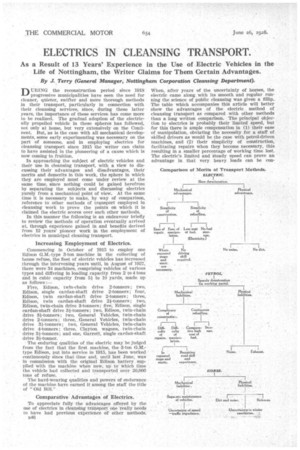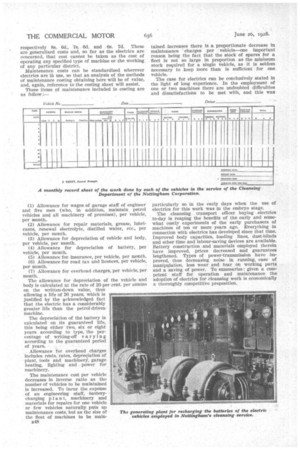ELECTRICS IN CLEANSING TRANSPORT.
Page 72

Page 73

Page 74

If you've noticed an error in this article please click here to report it so we can fix it.
As a Result of 13 Years' Experience in the Use of Electric Vehicles in the Life of Nottingham, the Writer Claims for Them Certain Advantages.
By J._Terry (General Manager, Nottingham Corporation Cleansing Department).
DUJUNG the reconstruction period since 1918 progressive municipalities have seen the need for cleaner, quieter, swifter and more thorough methods in their transport, particularly in connection with
their cleansing services, since, during these latter years, the importance of these services has come more to be realized. The gradual adoption of the electrically propelled vehicle in these spheres has followed, not only at home, but very extensively on the Continent. But, as is the case with all mechanical developments, some early experimenting was necessary on the part of someone, and in employing electrics for cleansing transport since 1915 the writer can claim to have assisted in the pioneering of a cause whieh is now coming to fruition.
In approaching the subject of electric vehicles and their use in cleansing transport, with a view to discussing their advantages and disadvantages, their merits and demerits in this work, the sphere in which they are employed must come under review at the same time, since nothing could be gained herefrom by separating the subjects and discussing electrics purely from a mechanical point of view. At the same time it is necessary to make, by way of comparison, reference to other methods of transport employed in cleansing work to prove the points on which it is claimed the electric scores over such other methods.
In this manner the following is an endeavour briefly to review the methods of operation eventually arrived at, through experience gained in and benefits derived from 12 years' pioneer work in the employment of electrics in municipal cleaning transport.
Increasing Employment of Electrics.
Commencing in October of 1915 to employ one Edison G.M.-type .3-ton machine in the collecting of house refuse, the fleet of electric vehicles has increased through the intervening years until, in August of 1927, there were 34 machines, comprising vehicles of various types and differing in loading capacity from 2 to 4 tons and in cubic capacity from 51 to 10 yards, made up as follows:— Five, Edison, twin-chain drive 2-tonners ; two, Edison, single cardan-shaft drive 2-tonners; four, Edison, twin cardan-shaft drive 2-tonners; three, Edison, twin cardan-shaft drive 21-tonners; two, Edison, twin-chain drive 3-tonners; five, Edison, single cardan-shaft drive 31-tonners; two, Edison, twin-chain drive 31-tonners; two, General Vehicles, twin-chain drive 2-tonners; three, General Vehicles, twin-chain drive n-tonners; two, General Vehicles, twin-chain drive 4-tonners ; three, Clayton wagons, twin-chain drive 31-tonners ; and one, Garrett, single card an-shaft drive 31-tonner.
The enduring qualities of the electric may be judged from the fact that the first machine, the 3-ton G.M.type Edison, put into service in 1915, has been worked continuously since that time and, until last June, was in commission with the original Edison battery supplied with the machine when new, up to Which time the vehicle had collected and transported over 20,000 tens of refuse.
The hard-wearing qualities and powers of endurance of the machine have earned it among the staff the title of " Old Bill." •
Comparative Advantages of Electrics.
To appreciate fully the advantages offered by the use of electrics in cleansing transport ope 'really needs to have had previens experience of other methods.
B40
When, after years of the uncertainty of horses, the electric came along with its smooth and regular running the science of public cleansing was given a fillip. The table which accompanies this article will better show the advantages of the electric method of cleansing transport as compared with other methods than a long written comparison. The principal objection to electrics is probably their limited speed, but for this there is ample compensation in (1) their ease of manipulation, obviating the necessity for a staff of skilled drivers as would be the case with petrol-driven machines, and (2) their simplicity of construction, facilitating repairs when they become necessary, this resulting in a smaller percentage of working time lost. The electric's limited and Steady speed can prove an advantage in that very, heavy loads can be con
tinuously carried and hauled with a minimum of wear and tear, resulting in longer life for both body and chassis.
General Methods of Operation.
In the allotting of cleansing work to electric vehicles primary attention must be paid to these points:— According to the bulk of materials to be loaded so must the body capacity be chosen.
According to the weight of materials to be carried so must the loading capacity in tons be suitable.
According to the contour of the district to be worked and length of haul so must the method of drive of the machine, gear ratio in relation to battery capacity, be suited.
In view of this and after years of rearrangement of the work of collecting house refuse by electrics, the methods at present obtaining here in Nottingham are as follow:— For districts of level thoroughfares and short hauls of 1 to 1 miles, loading very heavy and very bulky materials, the machine employed is of the 4-ton, ,largecapacity, low-gear ratio, twin-chain-driven type.
_ For districts with thoroughfares which vary in their levels, for long hauls of 3 to 4 miles and for heavy materials of considerable bulk, the machines in use are the 3-ton and 3i-ton, large-capacity medium-gear ratio, twin-chain and single-shaft-driven types.
For districts of hilly roads, for long and medium hauls of 2 to 31, miles and for materials of medium bulk and weight, 2i-ton, medium-capacity, high-gear ratio, twin-shaft-driven machines are employed.
For short or medium hauls and roads with varying levels, for materials of small weight but considerable bulk, twin-drive 2-tonners of medium-gear ratio are in use.
The machines giving the most continuously reliable results are the first named, commissioned in October, 1922, and maintained on this same heavy work since that date. This is due largely, of course, to the little wear and tear imposed on the machines by the level roads traversed in the course of their work and the short hauls involved, coupled with low speed and robust build of the vehicles.
Beyond this it can be definitely stated that the type of vehicle found most nearly to comply with all requirements and operating successfully under varying conditions is the 21-ton twin-shaft-driven machine having a body capacity of from 54to 6 cubic yards and a gear ratio of 14 to 1 (variable). It can be said of this machine that it is almost the ideal standby. In case of emergency it has been requisitioned to act as substitute for every other type of machine, to carry any quality of material, on any length-of haul, on any class of road whether level or hilly, and it has always come through successfully. So far as the fleet of vehicles under consideration is concerned no other class of machine has been called on for such varied tasks as this 2i-ton type, and frequently these tasks have entailed carrying a considerable overload.
Costs of Operating and Maintenance.
Costs of operating vary according to wages, cost of electricity, etc., and to give details in connection with this fleet of vehicles would be valueless here, except in so far as it would give a general idea of how costs are arrived at, and that idea will best be gained by reference to the accompanying sample of record and cost sheet given on the next page.
Three comparative costs, taken over considerable periods, which can be of value in proving the superiority of electrics over other methods of transport, are appended. They are the cost per ton of collection and haulage of house refuse in this city by horse transport, petrol transport and electric transport and are respectively 8s. 6d., 7s. 6d. and 6s. 7d. These are generalized costs and, so far as the electrics are concerned, that cost cannot be taken as the cost of operating any specified type of machine or the working of any particular district.
Maintenance costs can be standardized wherever electrics are in use, so that an analysis of the methods of maintenance costing obtaining here will be of value, and, again, reference to the costing sheet will assist.
These items of maintenance included in costing are as follow :— (1) Allowance for wages of garage staff of engineer and five men (who, in addition, maintain petrol vehicles and all machinery of premises), per vehicle, per month.
(2) Allowance for repair materials, grease, lubricants, renewal electrolyte, distilled water, etc., per vehicle, per month.
(3) Allowance for depreciation of vehicle and body, per vehicle, per month.
(4) Allowance for depreciation of battery, per vehicle, per month.
(5) Allowance for insurance, per vehicle, per month.
(6) Allowance for road tax and licences, per vehicle, per month.
(7) Allowance for overhead charges, per vehicle, per month.
The depreciation of the battery is calculated on its guaranteed life, this being either two, six or eight years according to type, the percentage of writing-off varying according to the guaranteed period of years.
Allowance for overhead charges includes rents, rates, depreciation of plant, tools and rnachiner, garage heating, lighting and power for machinery.
The maintenance cost per vehicle decreases in inverse ratio as the number of vehicles to be maintained is increased. To incur the expense • of an engineering staff, batterycharging p1 a n t, machinery and materials for repairs for one vehicle or few vehicles naturally puts up maintenance costs, but as the size of the fleet of machines to be main B48 tabled increases there is a proportionate decrease in maintenance charges per vehicle—one important reason being the fact that the stock of spares for a fleet is not so large in proportion as the minimum stock required for a Single vehicle, as it is seldom necessary to keep more than is sufficient for one vehicle.
The case for electrics can be conclusively stated in the light of long experience. In the employment of one or two machines there are undoubted difficulties and dissatisfactions to be met with, and this was particularly so in the early days when the use of electrics for this work was in the embryo stage.
The cleansing transport officer buying electrics to-day is reaping the benefits of the early and somewhat costly experiments of the early purchasers of machines of ten or more years ago. Everything in connection with electrics has developed since that time. Improved body capacities, loading lines, dust-blinds and other time and labour-saving devices are available. Battery construction and materials employed therein have improved, prices decreased and guarantees lengthened. Types of power-transmission have Improved, thus decreasing noise in running, ease of manipulation, less wear and tear on working parts and a saving of power. To summarize : given a competent staff for operation and maintenance the adoption of electrics for cleansing work is economically a thoroughly competitive proposition.




















































































































